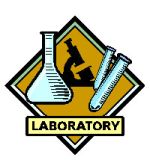| Page 2 |

|
|
1 - Chemical Safety
2 - Page 2 3 - Page 3 4 - Page 4 5 - Page 5 6 - Page 6 |

 HOME
HOME |
The following video is a supplement to the training session.
RunningTime: 14 minutes
Time
- Acute Health Hazards are those whose effects occur immediately or soon after you come in contact with them.
For example, you accidentally spill a strong acid on your hand. The acid will begin to burn your hand immediately. Or, you begin to work with a paint solvent in closed area, and the fumes make you feel dizzy.
- Chronic Health Hazards, on the other hand, are those whose effects take years or decades to occur after many exposures.
An example of a chronic health hazard would be asbestos. The dangerous effects for people who have been overexposed to asbestos take years to appear and have been linked to a number of fatal lung diseases.
Exposure
There are four basic ways you can be exposed to hazardous chemicals: inhalation; skin contact and absorption; ingestion; and injection.
- Inhalation of vapors, gases, mists, or particulates can cause damage through direct contact with respiratory tract tissues and be absorbed into the blood and circulated through the body with ulptake occuring in organs that have an affinity for the chemicals.
- Absorption through skin contact can cause anywhere from mild skin irritation to destruction of skin tissue. Rashes, cuts, and abrasions on skin increase the potential for chemicals to enter the body. Th eyes are particularly sensitive.
- Ingested chemicals do not generally harm the gastrointestinal tract itself unless the chemical are irritating or corrosive. Chemicals that are soluable are absorbed through the lining of the stomach and transported by blood to other internal organs.
- Injection of substances can happend if the skin is penetrated or punctured by contaminated objects. Effects can then occur as the substance is circulated in the blood and deposited in the organs
Hazardous chemicals are defined by OSHA as "any chemical which is a physical or a health hazard"
Examples of physical hazards are:
- Flammable Liquids with a flashpoint below 100 deg.F (37.8 deg.C), mostly organic liquids.
- Acetone, Benzene, Ethanol, Pyridine, Gasoline, Alcohol.
- P.S. Ever wonder why you are supposed to turn off cell phones at gas stations?
- Combustible Liquidhave a flashpoint at or above 100 deg.F (37.8 deg.C), but below 200 deg.F (93.3 deg.C).
- Ethanol, Acetaldehyde, Hexane, Acetone, Isopropanol.
- Compresses Gasses - a gas or mixture of gases having, in a container, an absolute preesre exceeding at least 40 psi at 70 deg.F (21.1 deg.C).
- Nitrogen and Oxygen.
- Explosive Chemicals that cause a sudden, almost instantaneous release of pressure, gas, and heat when subjected to sudden shock, pressure, or high temperature.
- Picric and Trinitrotoluene
- Organic Peroxides are compounds that contains bivalent -O-O- structure and which may be considererd to be a structural derivative of hydrogen peroxide where one or both of the hydrogen atoms has been replaced by an organic radical.
- Benzoyl peroxide is such a compound
- Reactive Chemicals will vigorously polymerize, decompose, condense, or will become self-reactive under conditions of shock, pressure, or temperature.
- Butylithium and Sodium
- Oxidizers, other and blasting agents, will initiates or promote combustion in other materials, thereby causing fire either of itself or through the release of oxygen or other gases.
- Perchloric Acid, Chromic Acid, and Fuming Nitric Acid
Examples of health hazards
- Carcinogens- chemicals evaluated by the International Agency for Research on Cancer (IARC) and found to initiate or speed the development of maligant tumors and neoplastic
- Benzene, Ethylene Oxide, Chloroform, Formaldehyde, Ethylene Amine
- Reproductive Toxins affect the reproductive capabilities including chromosomal damage and effects on fetuses.
- Mercury Compounds, Ethylene Oxide, Lead Compounds, Xylene, Toluene, Benzene
- Irritants are not corrosive but causes a reversible inflammatory effect on living tissues by chemical action at the site of contact
- Alkaline Dusts and Mists, Hydrogen Fluoride, Ammonia, Nitrogen Dioxide, Arsenic Trichloride, Ozone, Halogens, Phosgene, Hydrogen Chloride, Phosphorus Chloride
- Corrosive that causes visible destruction of, or irreversible alterations in, living tissue at the site of contact. Acid with pH<2 and bases with a pH>12 are especially dangerous.
- Acetic Anhydride, Glacial Acetic Acid, Bromine, Hydrochloric Acid, Hydrofluoric Acid, Potassium Hydroxide, Nitric Acid, Sodium Hydroxide, Chlorine, Sulfuric Acid
- Hepatotoxin means a chemical that produces liver damage.
- Carbon Tetrachloride, Nitrosamines, Tetrachloroethane, and Halogenated Solvents
- Nephrotoxin means a chemical that produces kidney damage.
- Lead and Halogenated Hydrocarbons.
| << Previous 1 [2] 3 4 5 6 Next >> |
